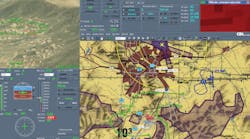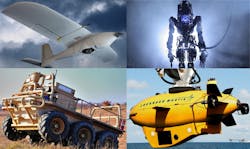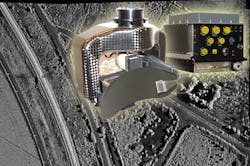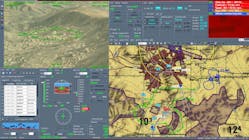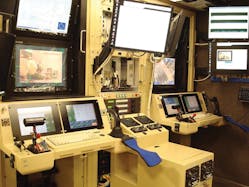This file type includes high resolution graphics and schematics when applicable.
Many factors are contributing to the rise and use of unmanned systems across a variety of industries. Air, sea, and land vehicles can provide relief, intelligence, speed, and efficiency in environments where manned operation may be infeasible or too costly (Fig. 1). Because artificial intelligence systems are still incapable of providing complete mission-ready and adaptable robots, manned control of these vehicles is still necessary.
To enable this control, reliable and feature-rich advanced communications and sensing systems are being heavily developed. RF/microwave/millimeter-wave communications and sensing technologies form the backbone of these modern systems. These technologies are being reviewed by military and commercial entities in order to increase the operational ability of unmanned aerial systems (UASs).
UASs have come a long way since the first simple unmanned aerial vehicles (UAVs)—WWII drone bombers and remote-control planes. Modern demands on these systems have increased the complexity of the radio control and electromagnetic sensors alike. They also have moved the development of these technologies out of the strictly military space. The requirements of small form factor, high configurability, low power, low weight, and broadband operation—which are seen throughout solutions in the RF/microwave industry—are all enabling more advanced UAS technologies. Another key trend that is spilling over to UASs is the benefit of networked platforms, which was first implemented by the telecommunications industry.
In addition, millimeter-wave technology is surfacing on UAV platforms in the form of higher-resolution radar for ground-moving-target-indicator (GMTI) operations (Fig. 2). Because millimeter-wave imagers are very compact and lightweight, they lend themselves to mobile platforms. Notably, synthetic-aperture-radar (SAR) -based millimeter-wave systems also are capable of photographic-quality images in a mixture of harsh environments: rain, smoke, fog, dust, and clouds. They also operate regardless of ambient light level. General Atomics Aeronautics manufactures its Lynx multi-mode radar using this technology. That radar can detect vehicular movements in real time at ranges to 80 km.
This file type includes high resolution graphics and schematics when applicable.
Communications Backbone
This file type includes high resolution graphics and schematics when applicable.
In 2012, the Defense Advanced Research Projects Agency (DARPA) issued a project aimed at providing mobile hotspots with advanced communications capabilities to support troops and warfighters in remote locations. Implementing reliable communications and data infrastructure has been a challenge for military personnel in remote geographic areas and diverse environments. The amount of tactical equipment and protocols that depend on a strong data backbone are rapidly increasing. Fortunately, the use of commercial-off-the-shelf (COTS) WiFi or Long-Term-Evolution (LTE) systems could bring a level of tactical connectivity not yet experienced. Building a mobile infrastructure capable of supporting reliable wireless technologies in remote tactical regions may be a costly and inflexible option. As a result, using UASs to create flying nodes for the mobile high-speed backbone has become a main target of this DARPA project.
The present vision for the project is to implement and demonstrate a scalable and mobile millimeter-wave communications-backhaul network. This network features nodes mounted on small UAVs that can provide reliable, long-range 1-Gbps capacity. To succeed in providing such capacity, several technologies required development. Among those are steerable millimeter-wave antennas that could rapidly establish a communications link between moving platforms while maintaining low power and a small footprint.
Other innovations included more efficient power amplifiers, lower-noise amplifiers, robust airborne networking techniques, and overall SWaP reductions. The current phase of this project, led by L-3 Communications and FIRST RF, is the incorporation of these technologies into aerial pods and ground vehicles. The next phase focuses on multi-UAV field testing using SRQ-7 Shadow UAVs and mobile ground vehicles.
Outside of DARPA, many companies are working on technologies that are well suited to UAS networking applications. Octasic Inc. has recently upgraded its line of embedded software-defined-radio (SDR) platforms with the OCTBTS 3000, thereby enabling LTE, OFDM, CDMA, HSPA, or GSM base-station capability. This SDR features packages capable of 400-MHz-to-6-GHz operation. It may prove viable for vendors looking to develop power-efficient, portable base-station capability including UAV-deployable base stations.
Northrup Grumman also embraced the COTS approach with its high-altitude, long-endurance (HALE) UAV platforms when the company redesigned its integrated mission management computer (IMMC). The IMMC acts as the central data interface for on-board sensors, relays, and the UAV communications link. Using COTS parts and actively relying on feedback with commercial vendors, the firm achieved a new IMMC design that improves cost, SWaP, and reliability by using scalable commercial technology nodes. At the same time, it reduces design risk and limits combat obsolescence.
Adapting technologies to UASs requires additional design considerations, which often fall outside of commercial applications. Solid-state power amplifiers (SSPAs) can offer many SWaP benefits for communications links for UAV systems. But they come with their own share of implementation difficulties. According to Ian Brassell, director of business development for Teledyne Microwave, “All of our devices are hermetically sealed, and that has proved to be an advantage. It helps to keep when altitude is involved and also to keep the muck and the dirt out. A lot of these units are field replaceable, so you have to be sensitive to providing unconditionally stable units.” Weatherproofing and ruggedness are not new concepts for military applications. As more commercial technologies are integrated in these platforms, however, the designs may need to be adapted to more rigorous requirements.
There also are electronic considerations for high reliability that commercial applications rarely see. “Our biggest design challenge is with dirty airborne power supplies operating with lots of spikes and transients,” Brassell explains. “An electromagnetic interference filter is needed to clean up the supply, and it often has to be incorporated in the same footprint as the PA…We have to increase the functionality of the SSPAs and converters for things like forward power monitoring and high-speed blanking. There are requirements to turn the transmitter off in stealth mode very quickly.”
As the hardware for UASs requires careful design, so do the software backbones that support these evolving platforms. To overcome the challenges of operating these systems with a host of controls and sensors, for example, Lockheed Martin developed its vehicle control station (VCS) software. This fully integrated COTS command, control, and information suite serves ground control operators of unmanned vehicle systems (UVSs).
Out of the over two million UAS mission flight hours flown by the U.S. military, over a million hours are attributed to the VCS. Many of its features help an operator generate more autonomous functions so that he or she can focus on the mission-critical aspects of the deployment. Examples of such functions include target management, zone restriction, network capability, mission editor, built-in flight modes, and video/sensor integration.
The sophistication of UAS hardware and software platforms has advanced to the point where the U.S. Navy officially released a solicitation for the design of an unmanned carrier launched airborne surveillance and strike (UCLASS) aircraft. It called for a competition of the four leading UAS providers: Boeing, Lockheed Martin, General Atomics, and Northrop Grumman. The system requirements include reconnaissance, surveillance, targeting, and strike capability to support carrier air-wing operations along with a complete control and connectivity platform.
To meet the deadline of a contract reward for 2015, these companies will most likely continue the trend of using COTS technology to enable rapid, SWaP-centric, and cost-effective designs. It also is likely that they will borrow some communications capabilities and techniques from the commercial market.
This file type includes high resolution graphics and schematics when applicable.
